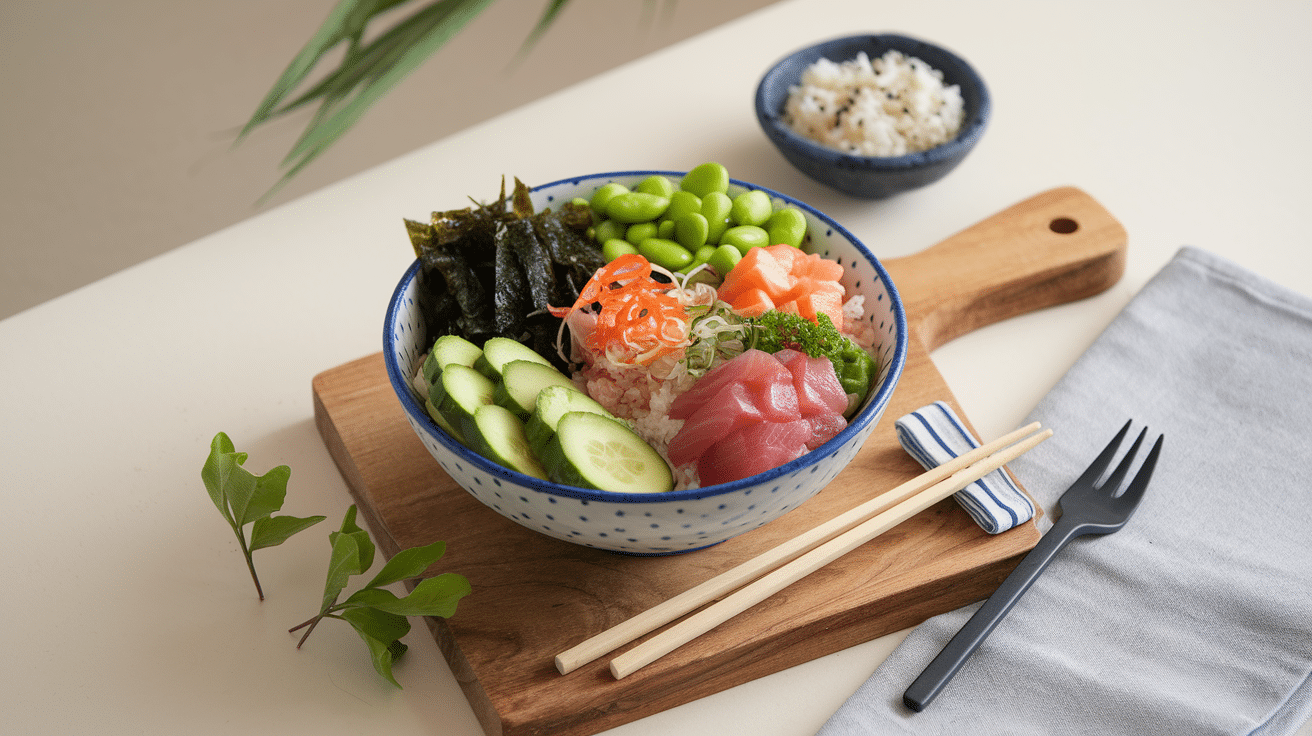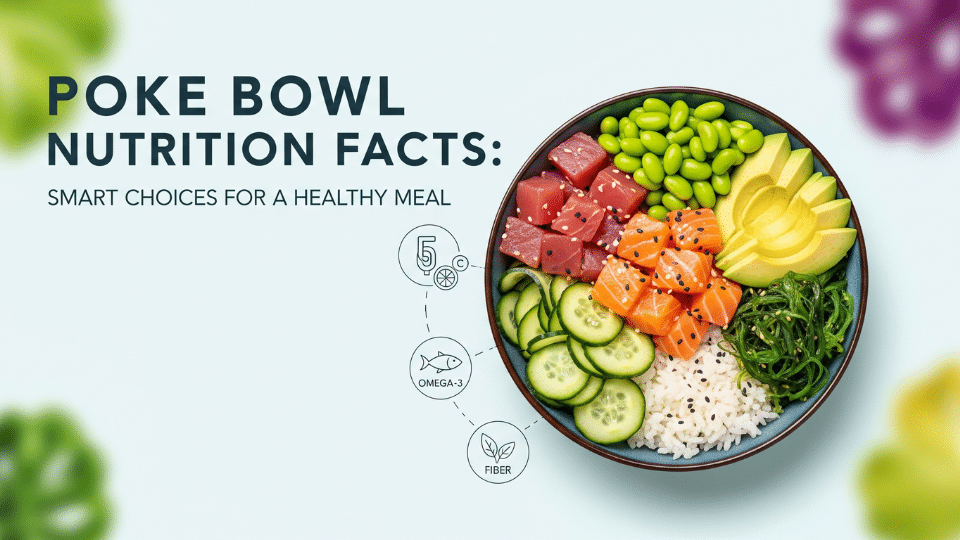Craving that colorful poke bowl from your local spot? You’re not alone. These Hawaiian-inspired bowls have taken the food world by storm. But what’s really in your favorite bowl?
Many people believe that poke bowls are inherently healthy. The truth might surprise you. Some bowls pack more calories than a burger and fries. Others offer a perfect balance of protein, healthy fats, and nutrients.
The key lies in understanding the nutrition facts of poke bowls. Smart choices can turn your meal into a nutritional powerhouse. Poor choices might sabotage your health goals.
Ready to make informed decisions about your next poke bowl? Let’s break down everything you need to know about poke bowl nutrition.
Let’s start with the basics and break down what makes these colorful bowls so popular.
What Is a Poke Bowl?
Poke bowls come from Hawaii. The word “poke” means “to slice” in Hawaiian. Local fishermen created this dish by cutting fresh fish into cubes and serving it raw, accompanied by sea salt and seaweed.
The dish spread to California in the 1970s. Japanese immigrants added rice to make it more filling. This created the modern poke bowl we know today.
Common Ingredients
Every poke bowl has four main parts:
Fish: Fresh tuna and salmon cut into cubes. The raw fish keeps all its natural nutrients and proteins.
Rice: White or brown rice forms the base. It fills you up and soaks up all the flavors.
Vegetables: Cucumber, edamame, and avocado add crunch. Seaweed salad brings ocean minerals to your bowl.
Sauces: Soy sauce, sesame oil, and spicy mayo tie everything together. Each sauce adds its own unique taste.
Why Poke Bowls Became Popular?
People love poke bowls for three key reasons.
First, they feature fresh ingredients with no heavy cooking or processing. You get whole foods in their natural state.
Second, they provide high protein through raw fish. This delivers complete protein and omega-3 fats your body needs.
Third, they’re easy to customize. You control every ingredient to match your goals.
The clean taste and healthy reputation made poke bowls popular nationwide. Now you can find them in most major cities.
Poke Bowl Nutrition Facts
Poke bowls look healthy, but appearances can fool you. Smart ingredient choices make the difference between a nutritious meal and a calorie trap.
🥗 Base Layer
🍣 Protein
🍤 Toppings
|
Now that you understand the nutritional breakdown, let’s explore how these nutrients benefit your health.
Health Benefits of Poke Bowls
Poke bowls offer more than just good taste. They offer significant nutritional benefits that support your overall well-being.
1. Rich in Lean Protein and Healthy Fats: Fresh fish delivers complete protein for muscle building and repair. It keeps you full between meals, too.
2. Omega-3 fatty acids: reduce inflammation and support brain function. They help your body absorb important vitamins. One poke bowl provides 25-40% of your daily protein needs. Salmon and tuna offer the most omega-3s per serving.
3. Packed with Vitamins, Minerals, and Fiber: Colorful vegetables bring different nutrients to your bowl:
- Green vegetables: folate and iron for healthy blood
- Orange carrots – beta-carotene for eye health
- Red peppers: vitamin C for immune support
- Seaweed: iodine for thyroid function
4. Good for Heart Health, Digestion, and Energy
- Heart benefits: Omega-3s help reduce inflammation in blood vessels. Fiber lowers cholesterol naturally. Potassium supports healthy blood pressure.
- Digestive benefits: Fiber feeds good gut bacteria. Raw vegetables provide natural enzymes for better nutrient absorption.
- Energy support: Balanced protein, fats, and complex carbs prevent energy crashes. B vitamins convert food into usable energy.
5. Fiber: from vegetables and grains aids digestion and controls blood sugar.
This combination keeps you satisfied and energized for 3-4 hours after eating.
Tips for a Balanced Poke Bowl
Building a nutritious poke bowl doesn’t have to be complicated. Follow these simple tips to create a meal that tastes great and supports your health goals.
Choose Lean Proteins
- Fresh fish tops the list for lean protein options. Tuna and salmon provide complete protein with minimal saturated fat.
- Shrimp offers another excellent choice. It delivers 24 grams of protein per 4-ounce serving with only 112 calories.
- Tofu works well for plant-based eaters. Choose firm or extra-firm varieties for the best texture and protein content.
- Avoid fried proteins like tempura shrimp or breaded fish. These add unnecessary calories and unhealthy fats to your bowl.
Opt for Whole Grains or Greens as a Base
- Brown rice provides more fiber and nutrients than white rice. The extra fiber helps you feel full longer.
- Quinoa offers complete protein plus complex carbs. It contains all nine essential amino acids your body needs.
- Mixed greens cut calories dramatically while boosting vitamin content. Spinach, kale, and arugula add different flavors and nutrients.
- Cauliflower rice works for low-carb diets. It saves 180+ calories compared to regular rice.
- Skip fried rice or noodle bases. These add extra oil and calories without much nutritional value.
Load Up on Colorful Veggies
Fill half your bowl with vegetables for maximum nutrition:
- Red vegetables: bell peppers, radishes, red cabbage
- Green choices: cucumber, edamame, broccoli
- Orange options: carrots, sweet corn
- Purple picks: red onions, purple cabbage
Each color provides different antioxidants and vitamins. More variety means better nutrition. Raw vegetables keep their enzymes intact. These help your body digest and absorb nutrients better.
Use Sauces Sparingly or Pick Lighter Options
Portion control matters most with sauces. Use 1-2 tablespoons maximum per bowl.
Lighter sauce choices:
- Ponzu: citrus-based with fewer calories
- Low-sodium soy sauce: classic flavor with less salt
- Rice vinegar: tangy with almost no calories
- Sesame oil: Use just a drizzle for a nutty flavor
Avoid heavy sauces:
- Spicy mayo: contains 90+ calories per 2 tablespoons
- Eel sauce: high in sugar and sodium
- Creamy dressings: pack extra calories and preservatives
Ask for sauce on the side. This lets you control exactly how much you use. Mix and match different light sauces. A little soy sauce plus rice vinegar creates great flavor without excess calories.
Conclusion
Poke bowls can be as light or filling as you make them. With their mix of fresh fish, colorful vegetables, and flexible bases, they’re a great way to pack in nutrition.
Keep an eye on sauces and portion sizes. Understanding poke bowl nutrition facts helps you make smart choices.
You can enjoy a meal that’s both tasty and healthy. Grab one from your favorite spot or build it at home. A balanced poke bowl fits easily into a healthy lifestyle.
Next time you order, you’ll know exactly how to build a bowl. Make choices that are good for both your taste buds and your body.









